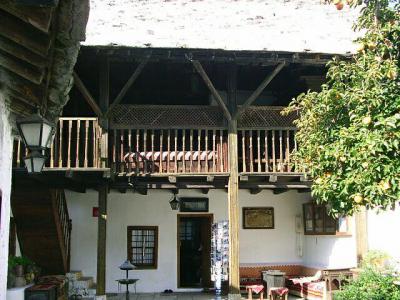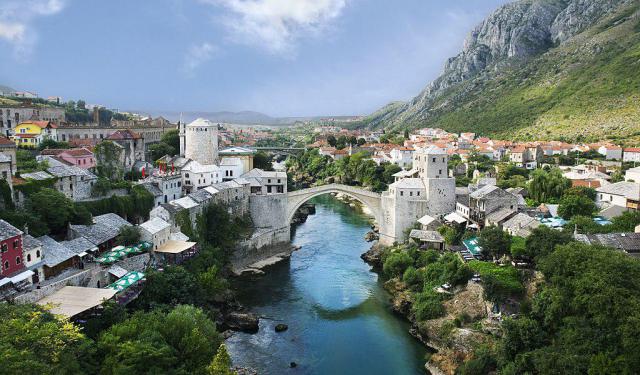
Biscevic House, Mostar
In the Ottoman era, neighborhoods called "mahallas" developed quickly along the banks of the Neretva River. Single-story and two-story houses were a bit unimpressive, as seen from the street, although they were comparatively rich and captivating inside.
The houses were studiously sited to capture picturesque views. But they were legally obligated not to block the views of neighbors. Entry from the street would lead to the courtyard, a transitional area that protected privacy. Family rooms were separated from reception rooms. The Biscevic House on the Neretva is an example of the most beautiful preserved residential structures from the Turkish period. It was built in 1635.
The entrance to the Bisevic residence is austere. Inside are rooms of built-in cabinetry, carved wood ceilings, and one room of pointed arch windows cantilevered over the swift-running Neretva below. High walls protectively surround the house. In a shady stone-paved patio a fountain burbles quietly.
At the entrance, Turkish slippers are provided for visitors. Along the edges of the rooms are divans, sofas, and oriental carpets and throws. Framed Arabic calligraphy adorns the walls. Photography is allowed. The visitor may try on traditional clothes stored on antique chests. There is a picture opportunity!
The houses were studiously sited to capture picturesque views. But they were legally obligated not to block the views of neighbors. Entry from the street would lead to the courtyard, a transitional area that protected privacy. Family rooms were separated from reception rooms. The Biscevic House on the Neretva is an example of the most beautiful preserved residential structures from the Turkish period. It was built in 1635.
The entrance to the Bisevic residence is austere. Inside are rooms of built-in cabinetry, carved wood ceilings, and one room of pointed arch windows cantilevered over the swift-running Neretva below. High walls protectively surround the house. In a shady stone-paved patio a fountain burbles quietly.
At the entrance, Turkish slippers are provided for visitors. Along the edges of the rooms are divans, sofas, and oriental carpets and throws. Framed Arabic calligraphy adorns the walls. Photography is allowed. The visitor may try on traditional clothes stored on antique chests. There is a picture opportunity!
Want to visit this sight? Check out these Self-Guided Walking Tours in Mostar. Alternatively, you can download the mobile app "GPSmyCity: Walks in 1K+ Cities" from Apple App Store or Google Play Store. The app turns your mobile device to a personal tour guide and it works offline, so no data plan is needed when traveling abroad.
Biscevic House on Map
Sight Name: Biscevic House
Sight Location: Mostar, Bosnia-Herzegovina (See walking tours in Mostar)
Sight Type: Attraction/Landmark
Guide(s) Containing This Sight:
Sight Location: Mostar, Bosnia-Herzegovina (See walking tours in Mostar)
Sight Type: Attraction/Landmark
Guide(s) Containing This Sight:
Walking Tours in Mostar, Bosnia-Herzegovina
Create Your Own Walk in Mostar
Creating your own self-guided walk in Mostar is easy and fun. Choose the city attractions that you want to see and a walk route map will be created just for you. You can even set your hotel as the start point of the walk.
Mostar Introduction Walking Tour
Settlements by the Neretva River, between Mount Hum and Mount Velez, go back to prehistoric times. Remains of fortified encampments, cemeteries, and Roman foundations have been discovered beneath present-day Mostar. The name Mostar was derived from a document dated 1474. It called the residents "Mostari" which means "bridge-keepers."
Mostar was strategically located between... view more
Tour Duration: 1 Hour(s)
Travel Distance: 1.6 Km or 1 Miles
Mostar was strategically located between... view more
Tour Duration: 1 Hour(s)
Travel Distance: 1.6 Km or 1 Miles
Bosnian War Tour
After the fall of Yugoslavia, there followed civil wars of particular savagery. In Bosnia, there were two distinct struggles. The first involved Serbs against Croats and Bosnians. The alliance of Croats and Bosnians proved effective, and the Serbs were repulsed. The Croats were mainly Christian, and the Bosnians were Muslim. There was antipathy between them.
The second part of the war was the... view more
Tour Duration: 1 Hour(s)
Travel Distance: 1.5 Km or 0.9 Miles
The second part of the war was the... view more
Tour Duration: 1 Hour(s)
Travel Distance: 1.5 Km or 0.9 Miles


